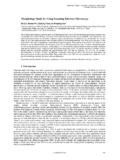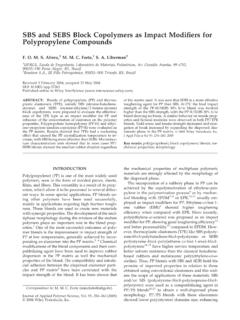Transcription of IDENTIFICATION OF FUNGI OF THE GENUS …
1 761 Brazilian Journal of Microbiology (2011) 42: 761-773 ISSN 1517-8382 IDENTIFICATION OF FUNGI OF THE GENUS aspergillus section nigri using polyphasic taxonomy Daiani M. Silva1; Lu s R. Batista*2; Elis ngela F. Rezende 2; Maria Helena P. Fungaro 3; Daniele Sartori 3; Eduardo Alves4 1 Universidade Federal de Lavras, Departamento de Biologia, Lavras, MG, Brasil; 2 Universidade Federal de Lavras, Departamento de Ci ncias dos Alimentos, Lavras, MG, Brasil; 3 Universidade Estadual de Londrina, Departamento de Biologia Geral, Londrina, PR, Brasil; 4 Universidade Federal de Lavras, Departamento de Fitopatologia, Lavras, MG, Brasil. Submitted: December 22, 2009; Returned to authors for corrections: July 20, 2010; Approved: January 13, 2011. ABSTRACT In spite of the taxonomy of the aspergillus species of the nigri section being regarded as troublesome, a number of methods have been proposed to aid in the classification of this section .
2 This work aimed to distinguish aspergillus species of the nigri section from foods, grains and caves on the basis in polyphasic taxonomy by utilizing morphologic and physiologic characters, and sequencing of -tubulin and calmodulin genes. The morphologic IDENTIFICATION proved useful for some species, such as A. carbonarius and aspergillus sp UFLA DCA 01, despite not having been totally effective in elucidating species related to A. niger. The isolation of the species of the nigri section on Creatine Sucrose Agar (CREA) enabled to distinguish the aspergillus sp species, which was characterized by the lack of sporulation and by the production of sclerotia. Scanning Electron microscopy (SEM) allowed distinguishing the species into two distinct groups.
3 The production of Ochratoxin A (OTA) was only found in the A. carbonarius and A. niger species. The sequencing of -tubulin gene was efficient in differing most of the aspergillus species from the nigri section with the exception of aspergillus UFLA DCA 01, which could not be distinguished from A. costaricaensis. This species is morphologically similar to A. costaricaencis for its low sporulation capacity and high sclerotia production, but it differs morphologically from A. costaricaensis for its conidial ornamentation and size of vesicles. Equally, based on partial calmodulin gene sequence data aspergillus UFLA DCA 01 differs from A. costaricaensis. Key words: polyphasic taxonomy , -tubulin gene, aspergillus spp morphology. INTRODUCTION Species of the GENUS aspergillus section nigri or the Black aspergillus are widely distributed around the world and have a capacity of developing in a vast variety of substrates.
4 Many species are able to cause deterioration of food although some of them are used in fermentation industries to produce organic acids, such as citric and gluconic acids, as well as *Corresponding Author. Mailing address: Departamento de Ci ncia dos Alimentos, Universidade Federal de Lavras, UFLA, Campus da UFLA. CEP 37200-000, Lavras-MG, Brazil.; Tel/Fax: + 55 35 3829-1399.; E-mail: 762 Silva, et al. IDENTIFICATION of FUNGI of the GENUS aspergillus hydrolytic enzymes like lipases and amylases (1, 26). A. niger is one of the species that is widely used in biotechnological processes and it is the only one that has the GRAS status (Generally Regarded As Safe) by the Food and Drug Administration.
5 However, some species of the section nigri distinguish themselves by producing mycotoxins. The taxonomy of FUNGI belonging to the section nigri comprises one of the most confusing and complex due to the subtle differences between the species. For a long time, classification and IDENTIFICATION of these species were studied through morphologic criteria (19, 22). In this manner, some species, such as A. carbonarius and the uniseriate species (A. japonicus e A. aculeatus), can be easily recognized through IDENTIFICATION manuals; while species related to the A. niger aggregate complex have been difficult to distinguish using morphologic criteria Samson et al. (22). polyphasic taxonomy has been used for IDENTIFICATION , as well as description of new species of the GENUS aspergillus (16, 18, 27).
6 Recently, the taxonomy of the section nigri is undergoing reinvestigation using polyphasic taxonomy , which uses different methods (morphologic, physiologic, metabolite production and important molecular data) with the aim of simplifying and elucidating this section s confusing taxonomy . The objective of this study was to use polyphasic taxonomy to identify species belonging to the section nigri isolated from different sources, such as foods, grains and caves. MATERIAL AND METHODS Morphologic analysis One hundred and ten FUNGI strains belonging to the section nigri were used in this study. All of them were obtained from the FUNGI Collection of the Mycology and Mycotoxins Laboratory of the Department of Food Sciences, Federal University of Lavras - Lavras MG, and were isolated from different products and environments as presented in Table 1.
7 After pure culture, the strains were inoculated into Petri dishes containing the culture medium CYA - Czapeck Yeast Agar (K2 HPO4 g; Czapek concentrate mL; Yeast extract, g, Agar g, Distilled water 1 Liter; Czapek concentrate NaNO3 , KCl , , , , , , Distilled water 100 mL) and MEA (Malt Extract Agar g, Peptone g, Glucose g, Agar g, Distilled water 1 Liter) at 25 C and CYA at 37 C; in OA (Oatmeal Agar CBS g of oats, g of Agar, Distilled water 1 Liter) at 25 C; CY20S (Czapeck Yeast Extract Agar with 20% of Sucrose, K2 HPO4 1 g, Concentrated Czapeck 10 mL, metal solution 1 mL ( 1%, 0,5%), Yeast extract g, Sucrose g, Agar g, Distilled water 1 Liter) at 25 C.
8 After 7 days of incubation, the microscopic and macroscopic characteristics were observed (14, 22, 23). Table 1. Species of the GENUS aspergillus used in this study. Species Origin Species Origin (0128) (01201) (0113) (01111) (01114) (01151) A carbonarius (01130) (01218) (01244) (0118) (0121) (01238) Cave Raisin Cave Raisin Raisin Cave Cave Raisin Pepper Raisin Raisin Raisin (01270) (01272) (0191) (01122) (01129) (01171) (01202) (0122) (0123) (01210) (01197) (01198) Pistachio nut Pistachio nut Raisin Raisin Raisin Raisin Cave Raisin Raisin Cocoa Raisin Raisin 763 Silva, et al. IDENTIFICATION of FUNGI of the GENUS aspergillus (0131) (0184) (0187) aspergillus sp DCA UFLA (01162) (01236) (01132) (01133) (01134) (01135) (01158) (0143) (01119) (01124) (01125) (0168) (01254) (01204) (01340) (01123) (01159) (01213) (01296) (01205) (01140) (01206) (01168) (01380) (01284) (01286) (01242) (01269) (01282) (01184) (01148) (0125) (01182) (01161) (01278) A niger (01207) A niger (01216) (0165) A niger (01292) A niger (01217)
9 Guarana Raisin Raisin Cave Guarana Raisin Raisin Raisin Raisin Raisin Raisin Raisin Raisin Raisin Raisin Bean Cave Hazelnut Raisin Cave Cashew nut Cashew nut Cave Raisin Cave Raisin Guarana Cashew nut Coffee Guarana Hazelnut Cocoa Cave Cave Cave Cave Cave Almond Cave Raisin Raisin Cashew nut Rice (01278) (0124) (0175) (01209) (0115) (0105) (0166) (0116) (0117) (0183) (01115) (01121) A. niger (01345) (01224) (01343) (81) (84) (78) (75) A .niger (72) (01208) Aggregate (0176) Aggregate (01235) Aggregate (01239) Aggregate (01172) Aggregate (01147) Aggregate (0119) Aggregate (01137) Aggregate (01175) Aggregate (01289) Aggregate (01257) Aggregate (01336) Aggregate (0192) Aggregate (01215) Aggregate (01191) (01248) (01196) (01176) (01200) (0102) (01144) (01260) (01233) Cave Raisin Raisin Cashew nut Raisin Raisin Raisin Raisin Raisin Raisin Raisin Raisin Raisin Guarana Raisin Coffee Coffee Coffee Raisin Raisin Almond Coffee Guarana Raisin Raisin Guarana Raisin Raisin Raisin Cocoa Bean Hazelnut Raisin Pistachio nut Cave Pepper Raisin Raisin Raisin Raisin Raisin Raisin Raisin Growth and acid production in CREA (Creatine Sucrose Agar)
10 Culture medium The capabilities of growth and production of acid by the cultures were tested in CREA medium (Creatine Sucrose Agar - Creatine g, Sucrose 30 g, KCl g, g, g, g, Bromocresol purple g, Agar g, Distilled water 1 Liter) according to Frisvad and Samson (7, 22). Determining the ochratoxigenic potential of the identified species In order to determine the toxigenic potential of the species, the Plug Agar methodology, described by Filtenborg & Frisvad (6), was used. Extraction of Genomic DNA Conidia of the aspergillus strains were inoculated in a complete liquid medium (NaNO3 g; KH2PO4 g; g; KCl g; FeSO4 g; ZnSO4 g; glucose g; Yeast extract g; Peptone g; Hydrolyzed 764 Silva, et al.)















